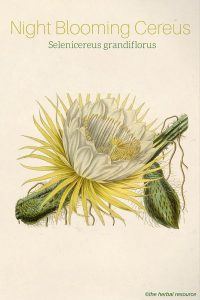The indigenous peoples of America have used the night blooming cereus as a topical remedy for rheumatism and itchy rashes, as well as an internal herbal remedy for worms, cystitis and fever.
The Native American tribe Death Valley Shoshone called this plant “pain in the heart”, and used it to treat angina-like pains.
Several other tribes of Native Americans use the stem to treat diabetes.
In the 15th century, Christopher Columbus brought this curative plant to Europe.
In 1586, the French physician and botanist Jacques Daléchamps described it in his Historia Generalis Plantarum.
In the 19th century, the Italian physician and medical director of the homeopathic hospital Santa Maria della Cesarea near Naples discovered that a tincture of the night blooming cereus had an antispasmodic effect on the coronary arteries and improved blood supply to the heart. He published his research in the British Journal of Homeopathy.
Night blooming cereus has a history of use in traditional herbal medicine as a treatment for hemoptysis (coughing up blood from the lungs) and edema (swelling of soft tissues due to the accumulation of excess water).
Selenicereus grandiflorus is perhaps best known for its use as an herbal treatment for heart conditions and it is highly valued by traditional herbalists as a natural treatment for heart palpitations, angina, weak or irregular pulse, and for relieving shortness of breath.
Additionally it is believed to be a useful natural treatment to help normalize heart rhythm and strengthens contractile force.
Night blooming cereus is also used by traditional herbalists as a natural treatment to tone the heart muscle, reduce blood fat and cholesterol, and increase circulation.
It is considered to be helpful as a diuretic, a stimulating cardiac tonic, a cardiac trophorestorative (a nutritive restorative for the body, usually with a strong affinity for an organ or organ system), and as a stimulant and tonic for the spinal and motor nerves.
It is thought that this herb could be useful to stabilize heart palpitations and valve inefficiency associated with arrhythmias, as well as dyspnea (shortness of breath) following a bout with pneumonia or other viral infection.
Night blooming cereus has been used as a homeopathic treatment for digestive ailments with flatulence and cramp-like pains, as well as an herbal remedy for pain associated with menstrual cramps.
Night blooming cereus is a traditional herbal treatment for nervous disorders of all types, sea and motion sickness, low body temperature, cold sweats, and edema.
[Read more about Night Blooming Cereus…]

It doesn’t say what part of the plant! Just the flower, which produces itself for only a few days every other year?
If you read the full article (link at the bottom) you can see it says “Plant Parts Used: The young succulent stems and flowers.”